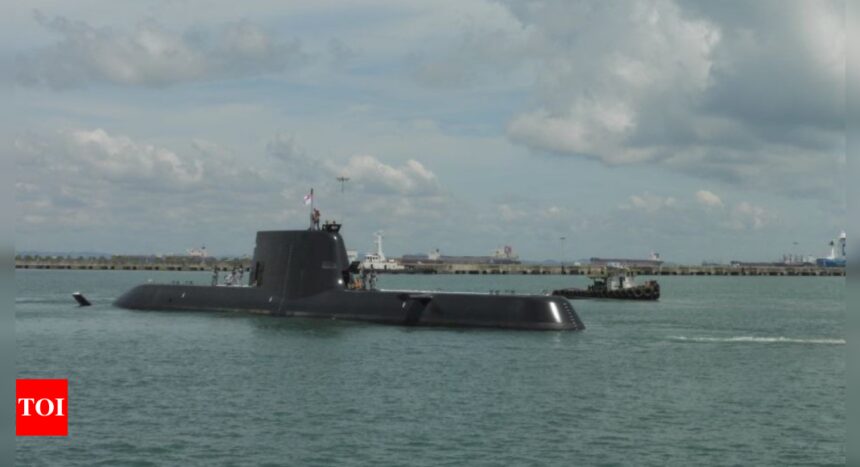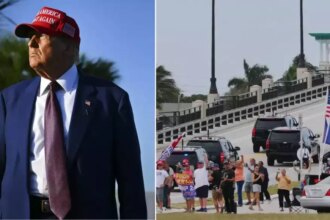SINGAPORE: Singapore commissioned two new advanced submarines on Tuesday, vessels its navy says are meant to protect sea lines of communication, and which experts said would range beyond the waters of the tiny city-state to keep tabs on the region.
The country’s fifth and sixth submarines, the Invincible and the Impeccable, were ordered from Germany’s ThyssenKrupp Marine Systems in 2013 in a 1-billion-euro deal, and join older Archer- and Challenger-class boats.
They represent a technological step forward for Singapore’s fleet, experts say, allowing the wealthy Southeast Asian nation to operate farther from shore using fewer sailors, and making its craft among the quietest in the region.
“They are an excellent force multiplier,” said Colonel Fong Chi Onn, commander of Singapore’s submarine flotilla. “And for a country as small as ours, we need all the force multipliers we can get.”
The two new Invincible-class submarines were moored at adjoining piers, decked in colourful naval pennants, with their X-shaped rudders peeking from the water, for Tuesday’s event at Changi Naval Base.
Prime Minister Lawrence Wong commissioned the vessels in a ceremony watched by their crew and military dignitaries in white dress uniforms gathered along with their families.
The Invincible class needs a complement of just 28 for each 70-metre (230 ft), 2,200-ton submarine, and crew said on Tuesday that automation of time-consuming tasks made operations easier. They are also Singapore’s first submarines with crew facilities for women, and both have female officers.
“They’re at least comparable to some of the latest, state-of-the-art conventional submarines now in service throughout Southeast Asia and the broader Indo-Pacific,” said Collin Koh, a naval affairs specialist at the S. Rajaratnam School of International Studies in Singapore.
However, simply having a more advanced sub did not mean it could match the capabilities of other regional navies, he added.
For example, the Invincible class is armed only with heavyweight torpedoes, while Vietnam’s Russian-designed Kilo submarines can carry land-attack cruise missiles.
Two more Invincible-class boats for Singapore, the Illustrious and Inimitable, have been launched but not yet commissioned.
The Invincible class is equipped with “air-independent propulsion,” which uses fuel cells to generate electricity rather than a standard diesel engine.
With few moving parts, these systems are extremely quiet, an obvious benefit for an underwater weapon. They can also permit submarines to keep submerged for weeks or even months, travelling thousands of kilometres.
Nuclear-powered submarines, such as those of China, Russia and the United States, are quieter in some cases, with much higher top speeds and longer range, but cost several billion dollars each.
The key role of undersea cables in recent years has made it critical for navies to be well-equipped for the undersea domain. This month, Reuters reported that the United States has been pressuring Vietnam to avoid a Chinese undersea cable company, out of concern over issues such as security.
China’s navy has also stepped up efforts to modernise its submarines, and is nearing completion of its Type 096 ballistic missile project.
Such ballistic missile submarines give nations an important strategic edge by allowing them to keep part of their nuclear arsenal hidden.
Singapore’s neighbour Indonesia has also been investing in submarines, ordering two advanced Scorpene-class boats from French state-owned shipyard Naval Group. Malaysia operates two older versions of the Scorpene class.
For Singapore, a close partner with the United States and its Asian allies, advanced submarines allow its military to play a bigger role in the naval drills analysts say are becoming more frequent and important in the Indo-Pacific region.
“I would also expect Singapore to provide a ‘target vessel’ for regional anti-submarine exercises,” said Trevor Hollingsbee, a former naval intelligence analyst with Britain’s defence ministry.
“These are always in demand, and it would provide them with concurrent intelligence collection opportunities.”
The country’s fifth and sixth submarines, the Invincible and the Impeccable, were ordered from Germany’s ThyssenKrupp Marine Systems in 2013 in a 1-billion-euro deal, and join older Archer- and Challenger-class boats.
They represent a technological step forward for Singapore’s fleet, experts say, allowing the wealthy Southeast Asian nation to operate farther from shore using fewer sailors, and making its craft among the quietest in the region.
“They are an excellent force multiplier,” said Colonel Fong Chi Onn, commander of Singapore’s submarine flotilla. “And for a country as small as ours, we need all the force multipliers we can get.”
The two new Invincible-class submarines were moored at adjoining piers, decked in colourful naval pennants, with their X-shaped rudders peeking from the water, for Tuesday’s event at Changi Naval Base.
Prime Minister Lawrence Wong commissioned the vessels in a ceremony watched by their crew and military dignitaries in white dress uniforms gathered along with their families.
The Invincible class needs a complement of just 28 for each 70-metre (230 ft), 2,200-ton submarine, and crew said on Tuesday that automation of time-consuming tasks made operations easier. They are also Singapore’s first submarines with crew facilities for women, and both have female officers.
“They’re at least comparable to some of the latest, state-of-the-art conventional submarines now in service throughout Southeast Asia and the broader Indo-Pacific,” said Collin Koh, a naval affairs specialist at the S. Rajaratnam School of International Studies in Singapore.
However, simply having a more advanced sub did not mean it could match the capabilities of other regional navies, he added.
For example, the Invincible class is armed only with heavyweight torpedoes, while Vietnam’s Russian-designed Kilo submarines can carry land-attack cruise missiles.
Two more Invincible-class boats for Singapore, the Illustrious and Inimitable, have been launched but not yet commissioned.
The Invincible class is equipped with “air-independent propulsion,” which uses fuel cells to generate electricity rather than a standard diesel engine.
With few moving parts, these systems are extremely quiet, an obvious benefit for an underwater weapon. They can also permit submarines to keep submerged for weeks or even months, travelling thousands of kilometres.
Nuclear-powered submarines, such as those of China, Russia and the United States, are quieter in some cases, with much higher top speeds and longer range, but cost several billion dollars each.
The key role of undersea cables in recent years has made it critical for navies to be well-equipped for the undersea domain. This month, Reuters reported that the United States has been pressuring Vietnam to avoid a Chinese undersea cable company, out of concern over issues such as security.
China’s navy has also stepped up efforts to modernise its submarines, and is nearing completion of its Type 096 ballistic missile project.
Such ballistic missile submarines give nations an important strategic edge by allowing them to keep part of their nuclear arsenal hidden.
Singapore’s neighbour Indonesia has also been investing in submarines, ordering two advanced Scorpene-class boats from French state-owned shipyard Naval Group. Malaysia operates two older versions of the Scorpene class.
For Singapore, a close partner with the United States and its Asian allies, advanced submarines allow its military to play a bigger role in the naval drills analysts say are becoming more frequent and important in the Indo-Pacific region.
“I would also expect Singapore to provide a ‘target vessel’ for regional anti-submarine exercises,” said Trevor Hollingsbee, a former naval intelligence analyst with Britain’s defence ministry.
“These are always in demand, and it would provide them with concurrent intelligence collection opportunities.”
Source : Times of India









